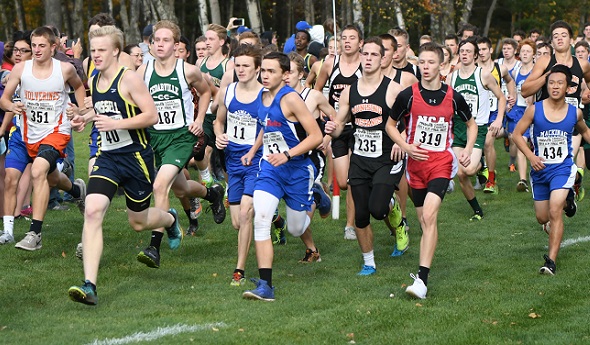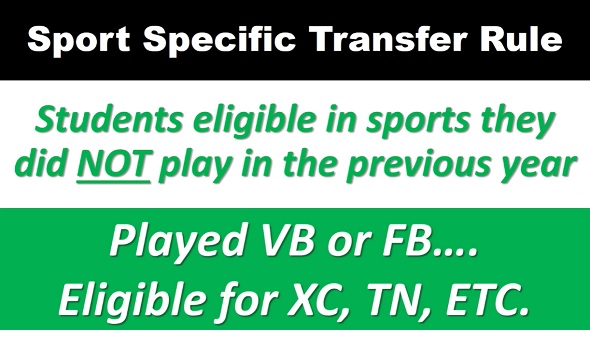
Participation Rises to 4-Year High
July 10, 2018
By Geoff Kimmerly
Second Half editor
While enrollment in MHSAA member high schools saw another slight dip in 2017-18, participation in the 28 sports for which the MHSAA sponsors postseason tournaments rose to its highest point since 2013-14.
A total of 284,920 participants competed in MHSAA-sponsored sports this past school year, up 0.46 percent from 2016-17 – and despite a 1 percent drop in enrollment at member schools during that time. The overall MHSAA participation totals count students once for each sport in which they participate, meaning students who are multiple-sport athletes are counted more than once.
Girls participation rose for the third straight year to 121,349 participants, up 1.2 percent from 2016-17 and despite a 1.1 percent enrollment drop over the last year. Boys participation fell to 163,571 participants, a decrease of less than a tenth of a percent from the previous year – and much smaller than the boys enrollment decrease of nearly a full percent.
Girls lacrosse has set a participation record every season since becoming a sponsored tournament sport in 2005, and did so this spring with 2,900 participants – a 3.1 percent increase from a year ago. Boys lacrosse also set a record for the second year in a row, up 1.1 percent with 5,168 participants. Both boys and girls bowling broke records previously set in 2015-16 – boys bowling participation increased 8.4 percent over 2016-17 with 4,136 participants, while girls bowling was up 4.5 percent with 3,058 athletes. Also setting a record in 2017-18 was boys cross country, which saw record participation for the second straight season last fall with 9,656 runners (an increase of 2.6 percent).
The largest percentage increase in participation this school year came in girls gymnastics, which jumped 10.4 percent with 702 athletes – its most since 2011-12. Girls golf also enjoyed a notable increase, up 4.2 percent to 3,712 athletes – its highest participation total since 2007-08.
Six sports total saw increases in participation on both the girls and boys’ sides. In addition to bowling and lacrosse, girls cross country joined the record-setting boys with a 2.4 percent increase. Girls and boys swimming & diving both enjoyed increases for the second straight year, this time both by 2.4 percent. Girls tennis was up 2.3 percent to its highest total (9,123) since 2012-13, and boys tennis participation increased by one percent. Boys track & field (1.5 percent) increased for the third straight year, while girls track & field (1.6 percent) was up for the second consecutive.
Volleyball led participation among girls sports with 19,416 participants, up 1.8 percent from 2016-17. Other sports to see increases in 2017-18 were girls skiing, up 2.8 percent as participation increased for the second straight season; boys basketball, up a half percent; and girls soccer, which had four more athletes this spring than during the 2017 season.
Also of note in this year’s survey:
• The increase in participation for 18 sports during 2017-18 was compared to an increase in 16 sports for 2016-17 and 15 sports in 2015-16.
• Of 10 sports that saw decreases in participation in 2017-18, five were down less than a percent. Competitive cheer had five fewer athletes but 6,715 total, and there were three fewer boys golfers to take that total to 2,267. Boys skiing was down six athletes total to 831, while boys soccer was down 11 athletes and girls softball down 31 – both less than a quarter of a percent off their 2016-17 totals.
• Football experienced a much smaller decrease in participation last season than it had from 2015-16 to 2016-17, falling only 1.9 percent to 37,002 athletes – still the most participating in any sport by more than 13,000 athletes. The combined number of 11 and 8-player varsity teams sponsored by MHSAA schools last fall remained constant compared to recent seasons, although a shift of some programs from 11-player to 8-player continued.
The participation figures are gathered annually from MHSAA member schools to submit to the National Federation of State High School Associations for compiling of its national participation survey. Results of Michigan surveys from the 2000-01 school year to present may be viewed by clicking here.
The following chart shows participation figures for the 2017-18 school year from MHSAA member schools for sports in which the Association sponsors a postseason tournament:
|
BOYS |
GIRLS |
|||
|
Sport |
Schools (A) |
Participants |
Schools (A) |
Participants (B) |
|
Baseball |
642/655/5 |
17,668 |
- |
0/7 |
|
Basketball |
730/729/1 |
21,367 |
691/723 |
15,654/5 |
|
Bowling |
385/391/18 |
4,098 |
360/381 |
3,058/38 |
|
Competitive Cheer |
- |
- |
343/353 |
6,715 |
|
Cross Country |
640/651/4 |
9,650 |
620/650 |
8,696/6 |
|
Football - 11 player |
578/582/89 |
35,475 |
- |
0/108 |
|
8-player |
71/74/10 |
1,406 |
- |
0/13 |
|
Golf |
506/530/66 |
6,146 |
340/339 |
3,712/121 |
|
Gymnastics |
- |
- |
83/96 |
702 |
|
Ice Hockey |
240/269/9 |
3,353 |
- |
292/12 |
|
Lacrosse |
154/161/5 |
5,161 |
109/113 |
2,900/7 |
|
Skiing |
96/107/1 |
830 |
95/107 |
767/1 |
|
Soccer |
484/506/20 |
14,550 |
468/483 |
13,216/69 |
|
Softball |
- |
- |
624/643 |
13,610 |
|
Swimming & Diving |
246/274/14 |
5,020 |
261/280 |
5,732/78 |
|
Tennis |
295/309/12 |
6,134 |
332/340 |
9,123/31 |
|
Track & Field |
668/686/2 |
23,566 |
659/685 |
17,288/14 |
|
Volleyball |
- |
- |
715/717 |
19,416 |
|
Wrestling |
467/482/152 |
9,147 |
- |
126/250 |
(A) The first number is the number of schools reporting sponsorship on the Sports Participation Survey. The second number indicates schools sponsoring the sport including primary and secondary schools in cooperative programs as of May 14, 2018. The third number indicates the number of schools that had girls playing on teams consisting primarily of boys.
(B) The second number indicates the number of additional girls playing on teams consisting primarily of boys and entered in boys competition.
The MHSAA is a private, not-for-profit corporation of voluntary membership by more than 1,500 public and private senior high schools and junior high/middle schools which exists to develop common rules for athletic eligibility and competition. No government funds or tax dollars support the MHSAA, w

Brush Up on the New Transfer Rule
July 18, 2019
By Rob Kaminski
MHSAA benchmarks editor
Eligibility under the new “sport-specific” transfer rule begins this coming fall after circulating extensively for nearly one school year.
Unless one of the stated 15 exceptions is met, participation during the 2018-19 school year determines eligibility for 2019-20.
The new rule adopted by the Representative Council at its May 2018 meeting has found support among most audiences. A transfer student’s eligibility in 2019-20 is based upon that student’s participation from this past school year (2018-19). It will be paramount for administrators and coaches to have awareness of the sports a transfer student participated in during the previous school year.
The long-standing 15 Exceptions to immediate eligibility, such as a full and complete residential change or a student moving between divorced parents by completing of an Educational Transfer Form, did not change.
One might call the rule on the way out “The Fourth-Friday Transfer Rule.” Under this old rule, when a student enrolled at the new school determined his or her eligibility. Under the new Sport Specific Transfer rule, what a student played in the previous season determines eligibility.
The Council passed a more lenient rule on the one hand and more restrictive on the other. The more lenient aspect is a change that finds a transfer student ELIGIBLE in any sport in which he or she did not participate in a game or a scrimmage in the previous school year.
The more restrictive portion tends to discourage students who change schools for sports reasons. A transfer student who did play a sport in the previous season – and who does not meet one of the 15 Exceptions – is NOT ELIGIBLE in that sport for the next season. If a student changes schools in mid-season, the student would be ineligible for the rest of that season in that sport and the next season for that sport.
Participation under this and other rules means playing in an interscholastic game or scrimmage after starting the 9th grade at any high school. It does not mean practice, but entering an interscholastic game, meet or scrimmage in any way. It also may involve more than one sport, so a three-sport athlete who does not have a residential change and transfers would be ineligible in those sports during the next school year – but eligible for any other sport. It also means a student cut from a team – one who never entered a scrimmage or game – may transfer and play without delay for that new school’s team. It may also mean that a student who meets one of the stated exceptions such as a residential change but enrolls in a school other than her or his school of residence, would have eligibility in sports not played in the previous year.
The new rule will tend to discourage students from changing schools for sports because they would be ineligible in any sport they have played in school the previous season for that sport. It will increase participation for some students who were otherwise not eligible under the current rule.
It is always best to contact school athletic directors who can connect with the MHSAA to verify eligibility prior to enrollment.
If the student’s new school requests in writing, the MHSAA Executive Committee may approve a waiver that reduces the period of ineligibility to 90 scheduled school days at the new school if the change of schools was for compelling reasons demonstrated with outside documentation having nothing to do with sports, curriculum, finances, and school demographics. The Executives Committee also has authority to approve immediate eligibility.

